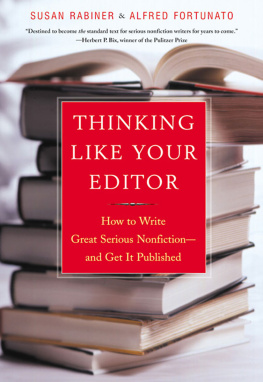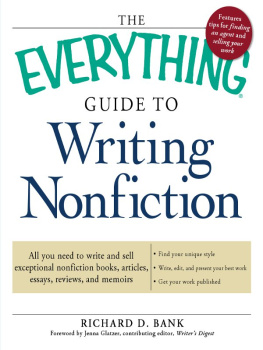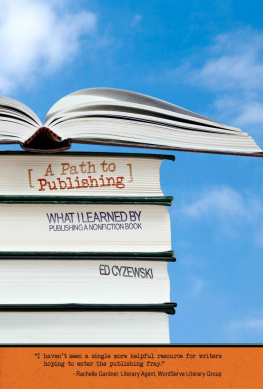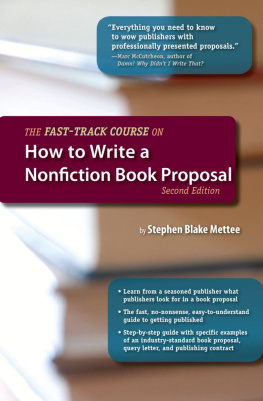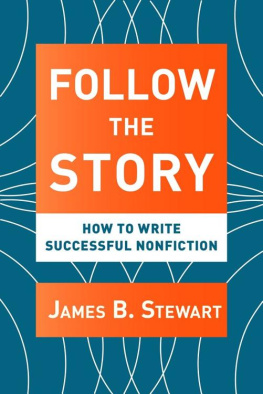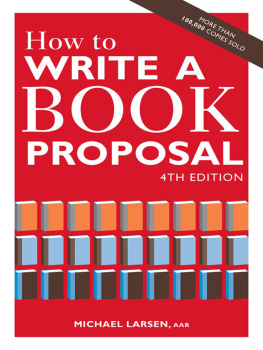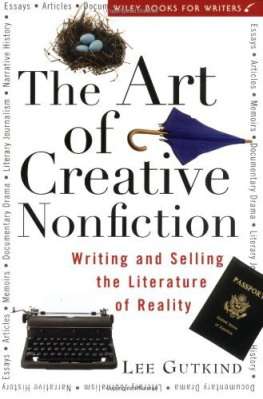What a smart and useful book Thinking Like Your Editor is. No other book in print addresses the art and craft of writing serious nonfiction booksthe kinds of books that change minds, enrich our intellectual lives, win major awardswith anything like the clarity of expression and depth of practical knowledge to be found herein. And unlike most books of advice, it is a positive pleasure to read. May it find a wide audience among writersand editors too, for that matter. Ill certainly be recommending it to both camps.
At lasta sensitive, thorough, and creative guide to writing nonfiction proposals and manuscripts. In forty-five years in publishing, I have never read better advice then this book offers. Bravo.
Rabiner and Fortunato take you through the corporate Oz of the publishing world, behind the smoke and mirrors, yet leave you with your creative heart intact.
Thinking Like Your Editor
How to Write Great Serious Nonfictionand Get It Published
Susan Rabiner and Alfred Fortunato

W. W. Norton & Company
New York London
Copyright 2002 by Susan Rabiner and Alfred Fortunato
All rights reserved
For information about permission to reproduce selections from this book, write to Permissions, W. W. Norton & Company, Inc., 500 Fifth Avenue, New York, NY 10110
Library of Congress Cataloging-in-Publication Data
Rabiner, Susan.
Thinking like your editor: how to write great serious nonfictionand get it published / by Susan Rabiner and Alfred Fortunato.
p. cm.
ISBN: 978-0-393-32461-7
1. AuthorshipMarketing. 2. Book proposals. 1. Fortunato, Alfred. II. Title.
PN161.R28 2002
808'.02dc21 2001044551
W. W. Norton & Company, Inc., 500 Fifth Avenue, New York, N.Y. 10110 www.wwnorton.com
W. W. Norton & Company, Ltd., Castle House, 75/76 Wells Street, London W1T 3QT
To Great Books
And the Authors Who Write Them
Contents
A Note to the Reader
T he book that follows is written in Rabiners voice. But it is the work of two peopleFortunato and Rabinerwho have spent a lifetime together talking about books and writing.
It worked out in our lives that Rabiner has dealt directly with authors, while Fortunato worked freelance on manuscripts. We continue very much in those roles even today, as we jointly run the Susan Rabiner Literary Agency. Because we wanted our book to echo the informal conversational sound of a meeting between editor and author, it made sense to write it in Rabiners voice.
But as in our personal lives, where we cant tell where one of us leaves off and the other begins, the ideas in this book evolved out of long years shared turning manuscripts into books.
Thinking Like Your Editor
Prologue
First, a little story
S everal years ago, while I was still editorial director of Basic Books, then the serious nonfiction division of HarperCollins, I went with two colleagues to a lunch meeting with buyers at Barnes & Noble. I had been especially looking forward to the lunch because I wanted an opportunity to persuade Barnes & Noble to change a shelving decision it had made on a title of ours just then being shipped to the bookstores.
Here is some background. At the top of our list that season was The Physics of Star Trek, a very entertaining book that also managed to teach some pretty high-level but fascinating physics. We had several early signs (a book-club sale, requests for excerpts from the book and online interviews with the author, a decision by Stephen Hawking to write the introduction) that this creatively conceived and executed book was a potential winner. Barnes & Noble apparently concurred in our judgment, placing the largest initial order for any title in Basics history. So we were rather confident we were on the road to a best seller. Until it became apparent we had a little hitch, at least with Barnes & Noble, regarding where in their bookstores all these copies were to be shelved.
Apart from copies of favored books piled high on the New Arrivals table at the front of every bookstore, every title must also be shelved in a category location farther back in the bookstore. B&N had decided to shelve The Physics of Star Trek in the science section, on its face a perfectly reasonable place for a title loaded with hard physics. Except that I believed a stronger market would develop among trekkers interested in hard science than among science readers interested in Star Trek . Indeed, the sales pitch for the book was the dream book for the techie in every trekker, and the editing, jacketing, marketing, and sales had all been designed to appeal to that audience, not to convert science readers into Star Trek fans.
So my job that day would be to persuade B&N that at least half of the copies to be stocked in the science section more properly belonged in the bookstores Star Trek section. Yes, gentle reader, there is indeed a special section in many bookstores, often larger than the stores entire science section, devoted to the many novelizations, technical manuals, or whatever, about or based on the Star Trek series.
B&N, like Borders and, more recently, Books-A-Million, are referred to in the publishing industry as the chains, short for the chain bookstores. For many years, you must know, hardly any of the oldtimers in publishing had a nice thing to say about them. They had, we believed, knocked the legs out from under the independent bookstores, those long-standing, cherished mom-and-pop book-shops that once dotted Americas Main Streets.
We resented the chains for another reason as well. They introduced to bookselling what seemed a too relentlessly businesslike way of choosing which books to stock, how long to stock them, and where in the store to display them. As the chains grew in size, power, and influence, many editors viewed with anxiety a publishing future that increasingly closed off both the sophisticated and the not-easily-characterized book, or the book that had a well-defined but small audience. Of course, pressure on editors to publish only those authors expected to sell really well is much older than chain bookstores. Publishing legend has it that the esteemed Alfred A. Knopf himself once asked his editors, Why cant we publish only best sellers?
By the mid-1990s, chain bookstore sales represented a staggeringly large percentage of all books sold. Chain dominance of the selling end, as well as other factors unrelated to retailing, such as the buyout of many small publishing houses by corporate conglomerates, made it inevitable that the once genteel publishing industry would have to become more businesslike. And so it did. For every project editors now take to their editorial boards, they must work up profit-and-loss projectionsinputting production and other costs against hoped-for first-year hardcover and paperback sales, foreign-language and book-club sales.
Editors are generally not business geniuses, but most quickly figured out that these profit-and-loss projections tend to favor one kind of bookthe kind that promises to establish itself quickly and sell well in hardcover over the first twelve months of publication. It puts at a disadvantage books whose initial potential is not clear, as well as those whose strength is backlist, in other words, those that may never take off in hardcover but sell for many years in paperback. And so, notwithstanding the increasing presence of dour MBAs looking over their shoulders, editors began to look for creative ways to ease in and out of the mix of sales projection numbers those that would nudge toward the good side the profit-and-loss statements on books they wanted to acquire. They did so (and do so to this day) not to deceive, but because they truly believe that the decision about which books to publish is best made editorially, not financially, that is, by asking such questions as: It this an important book? Is this a book that my publishing house can publish well? So quite often it is the decision to acquire that comes first; then the creative math follows, as editors figure out ways to mute signals that they are predicting too large a first-year sale solely because they passionately want a particular book on their list.

